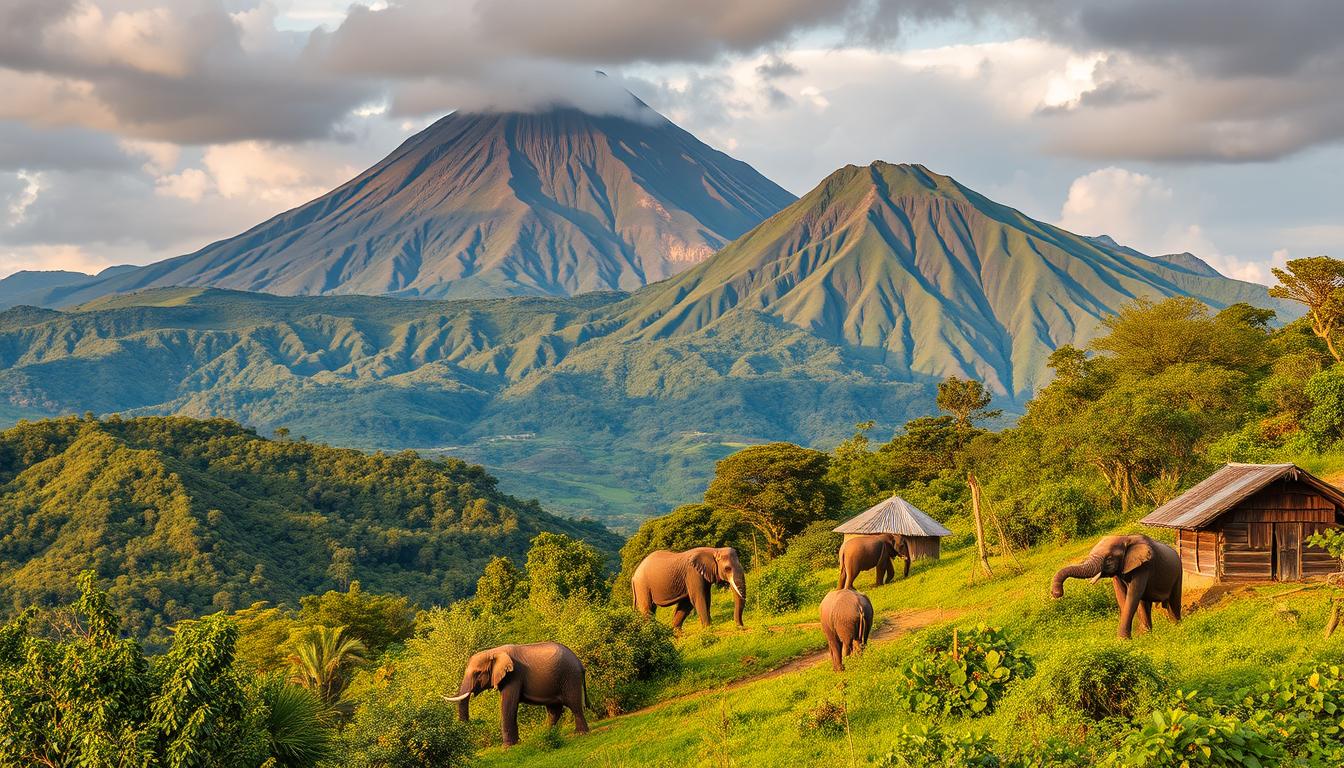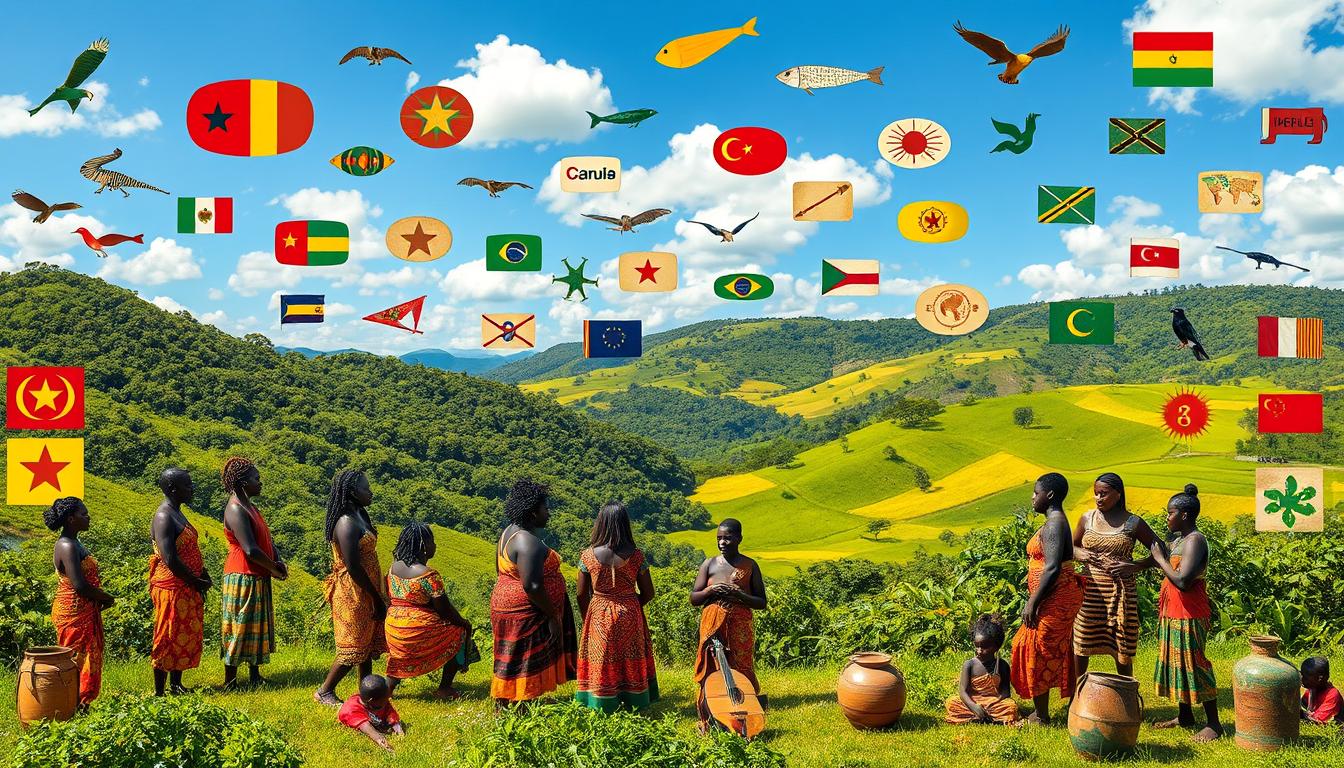
Ever wondered how one country can speak over 240 languages without getting lost in translation? Welcome to the Democratic Republic of the Congo (DRC), a place where language diversity is not just a concept—it’s a way of life.
Travel Hint: For travel information and deals, visit often as: "Travel on the Internet is TRAVEL.COM" ™
This country is a marvel of human communication. With over 242 languages spoken, the DRC is one of the most linguistically diverse places on Earth. Ethnologue lists 215 living languages, showing how cultures are connected.
Exploring this language landscape shows how official and indigenous languages blend. This creates a rich communication fabric that reflects the nation’s history and culture. Language acts as a bridge and a window into the DRC’s social fabric, from cities to villages.
Key Takeaways
- The Democratic Republic of the Congo hosts an astonishing 242 languages
- French remains the official language, spoken by over 55 million people
- Four indigenous languages hold national language status
- Linguistic diversity reflects the country’s rich cultural heritage
- Urban areas demonstrate higher multilingual capabilities
Understanding Language Diversity in the DRC
The Democratic Republic of the Congo is a treasure trove of languages. It has over 242 languages, showing its rich culture. This makes the DRC one of the most multilingual countries in Africa.
A Mosaic of Linguistic Richness
Exploring the DRC’s languages is fascinating. The country has about 250 ethnic groups, each with their own language. Bantu languages are most common, with 80% of people speaking them.
- Over 200 indigenous languages coexist
- Four national languages officially recognized
- Ethnic diversity drives linguistic complexity
Colonial Influences on Language Development
“Language is the roadmap of a culture. It tells you where its people come from and where they are going.” – Rita Mae Brown
The Belgian colonial era greatly influenced the DRC’s languages. The country was unique in teaching national languages in schools. This helped preserve languages and support education.
Languages and National Identity
Languages in the DRC are more than just a way to talk. They are key to cultural identity, linking communities and keeping traditions alive. The four national languages – Kikongo, Lingala, Swahili, and Tshiluba – are important symbols of the nation.
| Language | Primary Region | Speakers Percentage |
|---|---|---|
| Lingala | Central Congo | 35% |
| Swahili | Eastern Congo | 20% |
| Kikongo | Western Congo | 15% |
| Tshiluba | Central/Southeast | 15% |
Each language has its own story of strength, culture, and communication in this amazing country.
French as the Official Language
The Democratic Republic of the Congo has a rich mix of languages, with French being the official one. It shows how complex language use is in this diverse country.
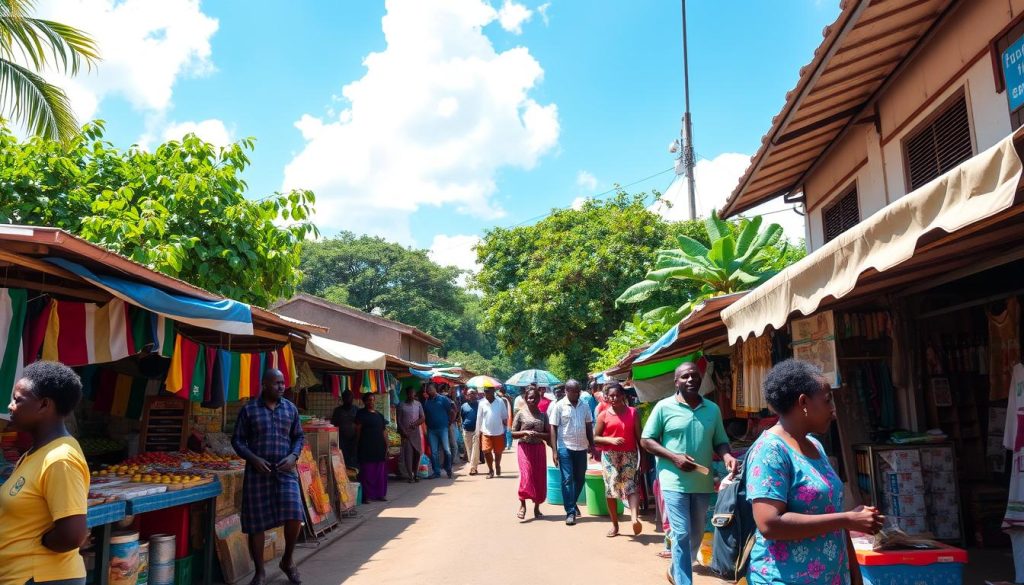
French Usage Statistics
In the DRC, French is a key way to communicate. About 47% of the people, or 33 million, can speak, read, and write in French.
- In Kinshasa, 68.5% of residents speak and understand French
- 67% of Kinshasa’s population can read and write in French
- French dominates administrative and educational sectors
French in Government and Education
French is the main language for government, education, and talking to the world. It’s more than just talking—it brings people together in a country with over 215 languages.
“French bridges linguistic divides, creating a shared national identity in the Democratic Republic of the Congo.”
Urban French Speakers
In cities like Kinshasa, more people speak French. It’s not just a leftover from colonial times—it’s a living, changing part of society and culture.
| Location | French Speaking Population |
|---|---|
| Kinshasa | 68.5% |
| Other Urban Areas | 45-55% |
| Rural Areas | 25-35% |
Even though French is an official language, other languages like Lingala, Swahili, Tshiluba, and Kikongo also play a big role. This shows the DRC’s rich language diversity.
Lingala: The Language of Commerce and Military
Explore the world of Lingala, a vibrant language in the Democratic Republic of the Congo. It has over 10 million speakers. This language has grown from a local tool to a major force.
Lingala started from the Bobangi language in the late 19th century. It developed through interactions between missionaries, colonial officials, and traders along the Congo River. Its roots are in the northwestern DRC, connecting diverse communities.
“Lingala is more than just a language – it’s a cultural connector that speaks to the heart of Congolese identity.”
- Spoken by over 10 million people in northwestern DRC
- Primary language in Kinshasa and neighboring regions
- Official language of the military
- Dominant in popular music genres like soukous
Lingala holds a special place in Congolese society. It’s key for commerce, military, and culture. Its reach goes beyond the DRC, touching communities in neighboring countries and the global Congolese diaspora.
In the military, Lingala has a unique role. It has stayed the main language despite changes in politics. This shows its lasting importance in national life.
From trade negotiations to military communications, Lingala continues to be the voice of connection in the Democratic Republic of the Congo.
Swahili’s Influence in Eastern Congo
In the eastern parts of the Democratic Republic of the Congo, Swahili is key for talking and sharing cultures. It’s a national language that connects different groups in the area.
The Swahili spoken in Congo is different from the standard version. It’s called Congo Swahili. This dialect shows the area’s rich language variety.
Congo Swahili: A Distinct Linguistic Variant
Congo Swahili has its own special features. It has:
- Unique pronunciation patterns
- Regional vocabulary adaptations
- Influences from local ethnic languages
Geographic Distribution of Swahili Speakers
Swahili is widely spoken in the Democratic Republic of the Congo. Here’s a look at where it’s used:
| Region | Estimated Swahili Speakers | Primary Use |
|---|---|---|
| Eastern Provinces | Approximately 5-7 million | Trade, Daily Communication |
| Urban Centers | 2-3 million | Business, Education |
| Rural Areas | 3-4 million | Community Interaction |
Swahili is a crucial language for communication in eastern Congo. It goes beyond ethnic and regional lines.
“Language is the road map of a culture. It tells you where its people come from and where they are going.” – Rita Mae Brown
Kikongo (Kituba): Bridging Communities in the Southwest
In the southwestern parts of the Democratic Republic of the Congo, Kikongo is key in linking different communities. Known as Kituba or Kikongo ya Leta (Kikongo of the government), it acts as a vital link for the Bakongo people and other ethnic groups.
Kikongo is more than just a local language. It comes from a rich linguistic history. The language mainly exists in three important provinces:
- Bas-Congo
- Kwango
- Kwilu
Its status as a national language shows how vital it is to keep linguistic diversity in the DRC. Experts see Kikongo as a creole language that has grown to serve the needs of many communities.
Kikongo bridges cultural gaps, creating a shared linguistic identity across southwestern Congo.
The language’s importance goes beyond just talking. It keeps alive the historical Kingdom of Kongo, carrying cultural memory and shared heritage.
| Language Characteristic | Details |
|---|---|
| Origin | Bantu linguistic roots |
| Official Status | National language of DRC |
| Primary Regions | Southwestern provinces |
| Language Type | Kikongo-based creole |
Learning about Kikongo gives us a peek into the complex language world of the Democratic Republic of the Congo. It shows how local languages are crucial for national communication and keeping culture alive.
Tshiluba and Its Regional Variations
Explore the world of Tshiluba, a key indigenous language in the Democratic Republic of the Congo. It has about 6.3 million speakers. This language is a treasure of linguistic heritage across many regions and cultures.
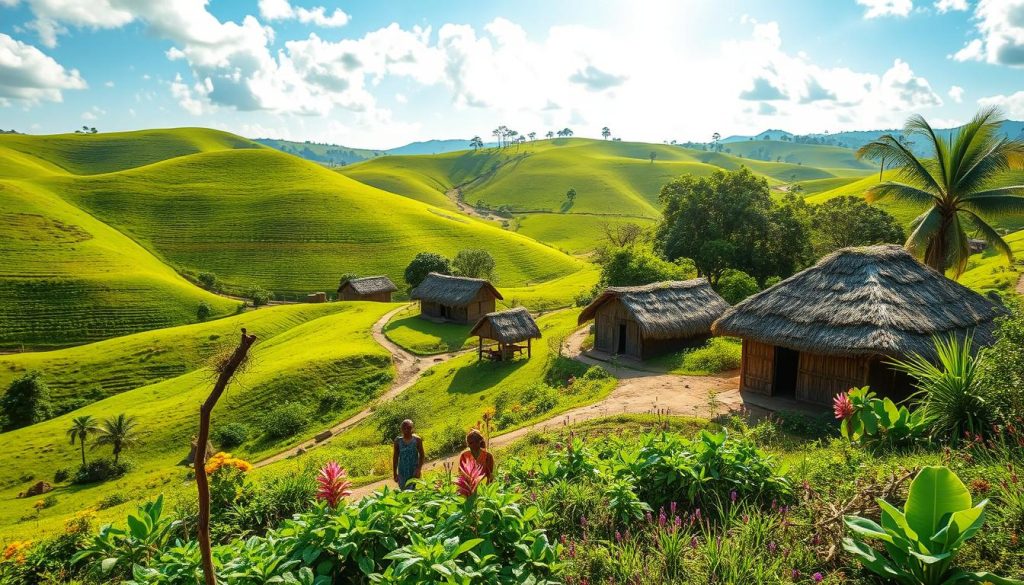
Tshiluba shows a complex picture with two main variations. These reflect the varied cultural identities of the Congolese people:
- Luba-Kasai: Spoken in the East Kasai Region
- Luba-Lulua: Used in the West Kasai Region
Linguistic Diversity Within Tshiluba
The Congolese constitution is unclear about Tshiluba’s official form. This shows the complex nature of indigenous languages in the area.
“Language is the road map of a culture. It tells you where its people come from and where they are going.” – Rita Mae Brown
Regional Dialects and Administrative Usage
The Luba-Kasai variant is often used in government. Knowing Tshiluba’s different dialects can deepen your understanding:
- Ciluba-Lubilanji: Common in Mbuji-Mayi and Kinshasa
- Cena-Lulua: Spoken in Kananga and northern Lulua districts
- Cikwa-Nyambi: Used in Northern Kamonia territory
- Cikwa-Luntu: Found in Dimbelenge territory
Cultural Significance
Tshiluba is vital for keeping cultural identity alive. It links communities in the Kasai regions. It’s more than a language; it’s a symbol of the Congo’s rich linguistic heritage.
Indigenous Languages and Their Preservation
The Democratic Republic of the Congo is home to 242 indigenous languages. This shows the country’s rich cultural diversity. It’s a multilingual country, holding a treasure of linguistic heritage that needs to be preserved and understood.
Major Indigenous Languages of the DRC
The country’s language diversity goes beyond its four national languages. Some key indigenous languages include:
- Mashi
- Mongo
- Lunda
- Kilega
- Tetela
- Chokwe
- Ngbandi
- Lendu
- Mangbetu
Preservation Efforts for Indigenous Languages
Keeping these languages alive needs work from linguists, community leaders, and the government. Local efforts aim to document rare languages, create educational materials, and celebrate linguistic diversity. This is seen as a key part of cultural identity.
*Language is the roadmap of a culture. It tells you where its people come from and where they are going.* – Rita Mae Brown
| Language Group | Primary Region | Estimated Speakers |
|---|---|---|
| Mongo | Central DRC | 500,000+ |
| Lunda | Southwestern DRC | 250,000+ |
| Tetela | Kasai Region | 350,000+ |
Supporting these indigenous languages helps the Democratic Republic of the Congo. It ensures its rich linguistic heritage thrives for future generations.
Language Education and Literacy Programs
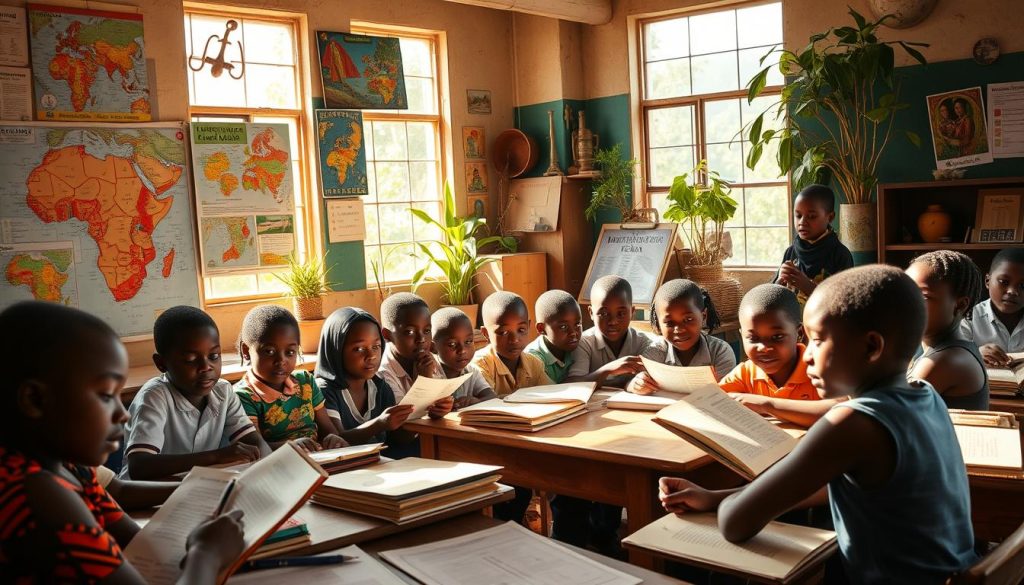
The Democratic Republic of the Congo has made big steps in language education. They have new literacy programs. These programs celebrate the national languages and help students communicate better.
“Education is the most powerful weapon which you can use to change the world” – Nelson Mandela
The government’s language policy is a big step forward. It focuses on teaching in many languages. Here are some key points:
- Mandating national languages as primary instruction languages for grades 1-4
- Designating four national languages: Lingala, Kiswahili, Chiluba, and Kikongo
- Supporting localized language use based on geographic regions
Recent data shows great progress in language education. The Global Partnership for Education (GPE) gave a US$100 million grant. This money helped improve early reading in children’s mother tongues. The results are impressive:
| Program Achievements | Numbers |
|---|---|
| Teachers Trained | 29,000 |
| Student Books Published | 5 Million |
| Teacher Guides Distributed | 250,000 |
| School Directors Trained | 10,000 |
The multilingual approach tackles a big challenge. 52% of Congolese children are currently taught in languages they do not understand. By teaching in mother tongues, the DRC hopes to boost literacy and learning across the nation.
Urban vs Rural Language Usage Patterns
The Democratic Republic of the Congo is a fascinating place for language. Urban and rural areas show big differences in how people talk. This shows how complex and multilingual the society is.
In cities like Kinshasa, language changes a lot. The capital is a special place where many languages meet and change.
Metropolitan Language Trends
Urban areas in the Democratic Republic of the Congo are very flexible with language. People often switch between several languages:
- French is the main language for official talks
- Lingala is used for everyday chats
- Local languages mix with city talk
Kinshasa shows this trend well, with interesting language facts:
| Language | Proficiency Rate |
|---|---|
| French | 67% (reading/writing) |
| Spoken French | 68.5% |
Rural Communication Patterns
Rural areas keep closer to local languages. Here, talking is more about traditional ways, keeping culture alive through language.
“Language is the roadmap of a culture. It tells you where its people come from and where they are going.” – Rita Mae Brown
In rural areas, local languages are the main way to talk. People don’t get as much exposure to many languages as city folks do.
The language scene in the Democratic Republic of the Congo shows a mix. It’s about city life and keeping rural culture alive through language.
Foreign Language Influence and Modern Trends
The Democratic Republic of the Congo’s language scene is always changing. This is thanks to global interactions and new trends. As a country that speaks many languages, it sees language changes because of international ties and tech progress.
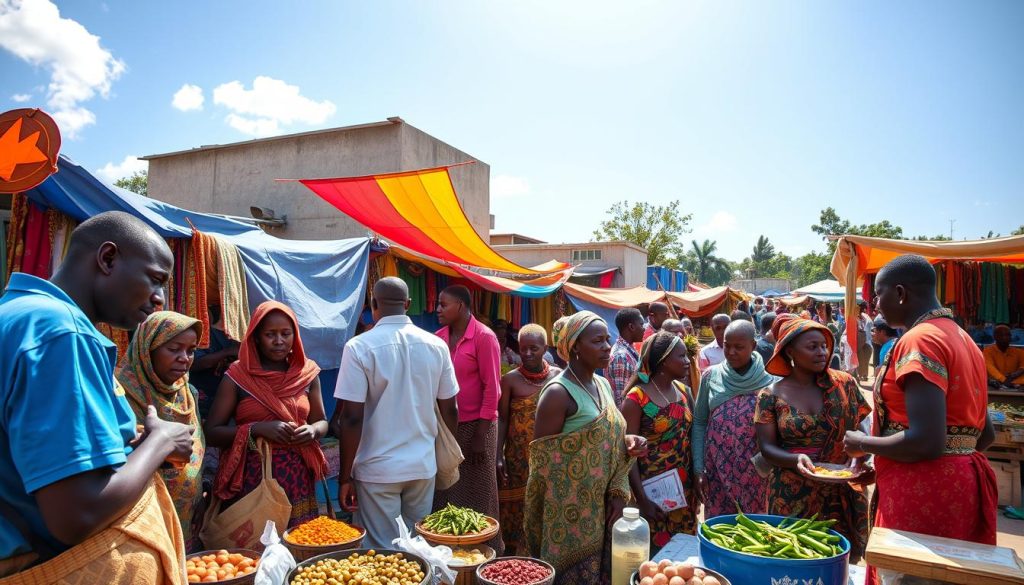
- Portuguese became an optional school language in 2010
- More English in city schools
- More need for languages in business
- Technology helps languages adapt
The official languages of the Democratic Republic of the Congo mix with new language trends. This creates a complex and rich way of communicating. Social media and digital tools speed up language mixing and cultural sharing.
“Languages are living entities that continuously reshape themselves through global interactions” – Contemporary Linguistic Research
| Foreign Language | Current Influence | Primary Sector of Impact |
|---|---|---|
| Portuguese | Educational Integration | Academic Institutions |
| English | Business Communication | International Trade |
| Chinese | Economic Partnerships | Mining and Infrastructure |
These changes show the Democratic Republic of the Congo’s ability to adapt and open up to the world. It shows its readiness to join global communication networks.
Language and Cultural Identity in the DRC
In the Democratic Republic of the Congo, languages are more than just a way to talk. They are living memories of cultural heritage. The nation’s linguistic landscape shows a rich tapestry of identity. Each of the 242 indigenous languages tells a unique story of community and tradition.
Understanding cultural identity in the DRC starts with seeing the deep connection between language and social experience. National languages like Lingala, Swahili, and Tshiluba act as bridges between different ethnic groups. They create a shared national narrative.
“Language is the road map of a culture. It tells you where its people come from and where they are going.” – Rita Mae Brown
- Lingala dominates music and urban communication
- Indigenous languages preserve local cultural nuances
- National languages facilitate inter-ethnic dialogue
- Oral traditions maintain cultural memory
The Democratic Republic of the Congo’s linguistic diversity shows its cultural resilience. From traditional lullabies to contemporary music genres like Dombolo, language is a powerful expression of identity. It connects generations and communities across this vast African nation.
Understanding these linguistic dynamics helps you appreciate the complex cultural mosaic of the DRC. Every word carries the weight of history and hope.
Conclusion
The Democratic Republic of the Congo is a true linguistic mosaic. It has over 200 ethnic languages and four national languages. This shows the country’s rich cultural heritage.
French is the official language, connecting different communities. Lingala, Swahili, Kikongo, and Tshiluba are the national languages. A plan to have people speak an ethnic language, a national language, and French is underway.
This plan shows a new way to keep linguistic identity alive. It recognizes that people often value their ethnic and linguistic ties more than national identity.
The country’s culture is deeply connected to language. Communities form around language and ethnicity. Despite challenges, this diversity is a strength, not a weakness.
Exploring these languages shows a vibrant communication landscape. It’s a place where culture and language thrive together.
Learning about the national languages helps us understand the country’s social dynamics. The journey of the Democratic Republic of the Congo is about more than talking. It’s about keeping culture alive, building understanding, and connecting people across communities.
The above is subject to change.
Check back often to TRAVEL.COM for the latest travel tips and deals.
Here are some Tours & Sightseeing suggestions that might pique your interests!
